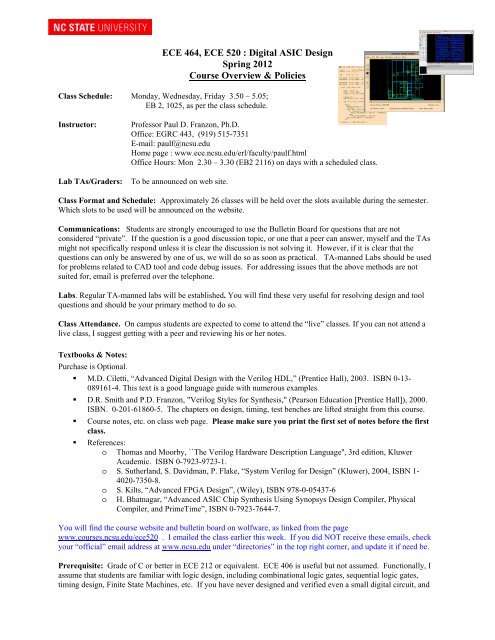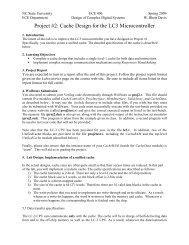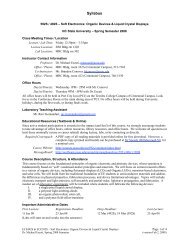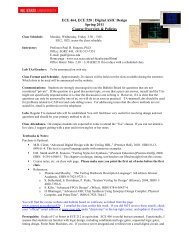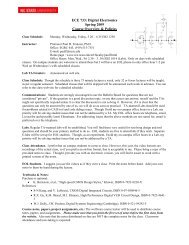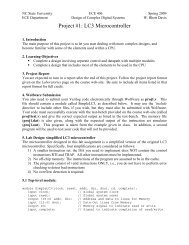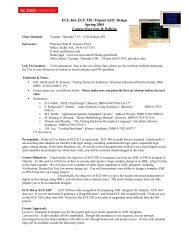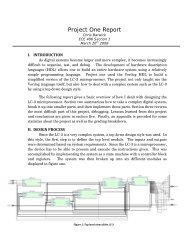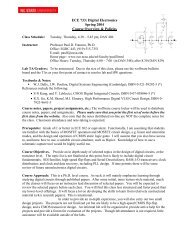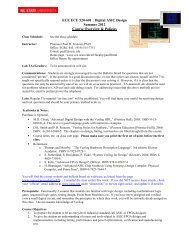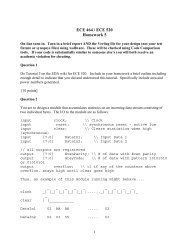Create successful ePaper yourself
Turn your PDF publications into a flip-book with our unique Google optimized e-Paper software.
ECE 464, ECE 520 : Digital ASIC Design<br />
Spring 2012<br />
<strong>Course</strong> Overview & Policies<br />
Class Schedule: Monday, Wednesday, Friday 3.50 – 5.05;<br />
EB 2, 1025, as per the class schedule.<br />
Instructor: Professor Paul D. Franzon, Ph.D.<br />
Office: EGRC 443, (919) 515-7351<br />
E-mail: paulf@ncsu.edu<br />
Home page : www.ece.ncsu.edu/erl/faculty/paulf.html<br />
Office Hours: Mon 2.30 – 3.30 (EB2 2116) on days with a scheduled class.<br />
Lab TAs/Graders: To be announced on web site.<br />
Class Format and Schedule: Approximately 26 classes will be held over the slots available during the semester.<br />
Which slots to be used will be announced on the website.<br />
Communications: Students are strongly encouraged to use the Bulletin Board for questions that are not<br />
considered “private”. If the question is a good discussion topic, or one that a peer can answer, myself and the TAs<br />
might not specifically respond unless it is clear the discussion is not solving it. However, if it is clear that the<br />
questions can only be answered by one of us, we will do so as soon as practical. TA-manned Labs should be used<br />
for problems related to CAD tool and code debug issues. For addressing issues that the above methods are not<br />
suited for, email is preferred over the telephone.<br />
Labs. Regular TA-manned labs will be established. You will find these very useful for resolving design and tool<br />
questions and should be your primary method to do so.<br />
Class Attendance. On campus students are expected to come to attend the “live” classes. If you can not attend a<br />
live class, I suggest getting with a peer and reviewing his or her notes.<br />
Textbooks & Notes:<br />
Purchase is Optional.<br />
� M.D. Ciletti, “Advanced Digital Design with the Verilog HDL,” (Prentice Hall), 2003. ISBN 0-13-<br />
089161-4. This text is a good language guide with numerous examples.<br />
� D.R. Smith and P.D. Franzon, "Verilog Styles for Synthesis," (Pearson Education [Prentice Hall]), 2000.<br />
ISBN. 0-201-61860-5. The chapters on design, timing, test benches are lifted straight from this course.<br />
� <strong>Course</strong> notes, etc. on class web page. Please make sure you print the first set of notes before the first<br />
class.<br />
� References:<br />
o Thomas and Moorby, ``The Verilog Hardware Description Language'', 3rd edition, Kluwer<br />
Academic. ISBN 0-7923-9723-1.<br />
o S. Sutherland, S. Davidman, P. Flake, “System Verilog for Design” (Kluwer), 2004, ISBN 1-<br />
4020-7350-8.<br />
o S. Kilts, “Advanced FPGA Design”, (Wiley), ISBN 978-0-05437-6<br />
o H. Bhatnagar, “Advanced ASIC Chip Synthesis Using Synopsys Design Compiler, Physical<br />
Compiler, and PrimeTime”, ISBN 0-7923-7644-7.<br />
You will find the course website and bulletin board on wolfware, as linked from the page<br />
www.courses.ncsu.edu/ece520 . I emailed the class earlier this week. If you did NOT receive these emails, check<br />
your “official” email address at www.ncsu.edu under “directories” in the top right corner, and update it if need be.<br />
Prerequisite: Grade of C or better in ECE 212 or equivalent. ECE 406 is useful but not assumed. Functionally, I<br />
assume that students are familiar with logic design, including combinational logic gates, sequential logic gates,<br />
timing design, Finite State Machines, etc. If you have never designed and verified even a small digital circuit, and
emember the principles by which they work, you will be seriously disadvantaged in this class. I do not assume<br />
knowledge of Verilog.<br />
<strong>Course</strong> Objectives<br />
1. To prepare the student to be an entry-level industrial standard cell ASIC or FPGA designer.<br />
2. To give the student an understanding of issues and tools related to ASIC/FPGA design and<br />
implementation, including timing, performance and power optimization, verification and manufacturing<br />
test.<br />
<strong>Course</strong> Outcomes<br />
1. Students will be able to design and synthesize a complex digital functional block, containing over 1,000<br />
gates, using Verilog HDL and Synopsys Design Compiler.<br />
2. Students will demonstrate an understanding of how to optimize the performance, area, and power of a<br />
complex digital functional block, and the tradeoffs between these.<br />
3. Students will demonstrate an understanding of issues involved in ASIC design, including technology<br />
choice, design management, tool-flow, verification, debug and test, as well as the impact of technology<br />
scaling on ASIC design.<br />
ECE 464 or ECE 520? ECE 520 has wide recognition for preparing ASIC designers for industry. ECE 464<br />
does not. If you are interested in gaining a “job qualification”, and found ECE 406 straightforward, I’ll advise you<br />
to take ECE 520, rather than 464. However, the ECE 520 is an order of magnitude more difficult than the 464<br />
project and includes a strong design optimization component. The 464 project does not require much optimization.<br />
<strong>Course</strong> Approach:<br />
Lectures: Designed to prepare you for the project and cover issues important to ASIC designers.<br />
Laboratories: A lab schedule will be established. Though lab attendance is not required, you are strongly<br />
encouraged to use the help available in the labs to sort through homework and project issues. In fact, only minimal<br />
help will be available outside the laboratory times.<br />
Homeworks: The homeworks are designed to either help you gain the skills required for the project or to help<br />
prepare you for the exams. Collaboration is encouraged though each student is expected to turn in individual<br />
solutions.<br />
Project: A fixed project will be published for each class. The project will be done by the students in pairs. You<br />
will be evaluated as a pair.<br />
Written Exams : There will be two written exams, a one hour midterm and a three hour final. Both are<br />
comprehensive, open-book, open-notes exams.<br />
<strong>Course</strong> <strong>Syllabus</strong><br />
1. Introduction to ASIC design<br />
2. Timing design<br />
3. Design of digital hardware using Verilog HDL I<br />
4. Design of digital hardware using Verilog HDL II<br />
5. Design of complex systems. Managing hierarchy.<br />
6. Verification.<br />
7. Design for Test.<br />
8. Low Power Design.<br />
9. Introduction to FPGAs<br />
Homework TurnIn<br />
o On-campus students. Unless specifically requested, please bring a paper copy to class.<br />
Student Evaluation<br />
Item Date ECE 520 ECE 464<br />
Homeworks 25% 25%<br />
Midterm Exam February, 20 10% 10%<br />
Project – Prelim Report March 2 5% 5%<br />
Project – Final Report April 18 40% 40%<br />
Final Exam Wednesday, May 2, 1-4 pm 20% 20%
Each non-exam item can be up to one week late with a 10% penalty. After more than a week, the item can not be<br />
accepted. Exams are open book, open notes. You may NOT use computers, mobile phones and PDAs during<br />
exams. Though you can collaborate during homeworks, direct copying of solutions, in part or in whole, is not<br />
permitted. All code required for the homeworks should be individually designed and developed. We will be<br />
running code comparison tools on homework solutions, and projects. An Audit requires completing all the<br />
homeworks with a grade of at least 80%.<br />
EOL Students<br />
The differences for you are as follows:<br />
� One TA will be designated as your major point of contact. He/she will most likely organize electronic<br />
office hours using elluminate<br />
� Please turn in all homeworks and reports on-line via wolfware assignment submit function<br />
� All tools are available remotely. Please see the class web site (“resources”) about how to do this. You will<br />
need to access to Verilog simulator and Synthesis tool. A stripped down simulator is available with the<br />
Ciletti book. You can use the Xilinx ISI student package but note that it is only good for 30 days (after<br />
which you would have to use the on-campus installation.) You are free to use tools and cell libraries<br />
available at your workplace but I don’t want NCSU exposed to confidentiality issues. ( Note, on campus<br />
students are expected to use the on campus tool and libraries.)<br />
� Your due dates are the same as for the on-campus students, except midterm and final are held the day<br />
AFTER the on-campus test/exam<br />
� You will need a proctor for your exams – please try to find one now who is willing and available<br />
Important Dates<br />
See Class Schedule<br />
Instructor Research Interests<br />
o Application specific processors. Current projects are in applications of 3DICs and secure IP design.<br />
o Interconnect, including transceivers, electronic packaging, on-chip interconnect, and between-chip<br />
interconnect.<br />
o Nanocomputing – how to build the computers that will eventually displace or complement CMOS.<br />
Students with disabilities<br />
Reasonable accommodations will be made for students with verifiable disabilities. In order to take advantage of<br />
available accommodations, students must register with Disability Services for Students at 1900 Student Health<br />
Center, Campus Box 7509, 515-7653. http://www.ncsu.edu/provost/offices/affirm_action/dss/ For more information<br />
on NC State's policy on working with students with disabilities, please see<br />
http://www.ncsu.edu/provost/hat/current/appendix/appen_k.html<br />
Academic integrity<br />
All the provisions of the code of academic integrity apply to this course. In addition, it is my understanding and<br />
expectation that your sumission of any test or assignment means that you neither gave nor received unauthorized<br />
aid. My policy for homeworks and projects is that while you are free to collaborate, sharing of design data,<br />
specifically Verilog code, is expressly forbidden. If you collaborate on a design problem, I still expect you to<br />
turn in individually developed code.


